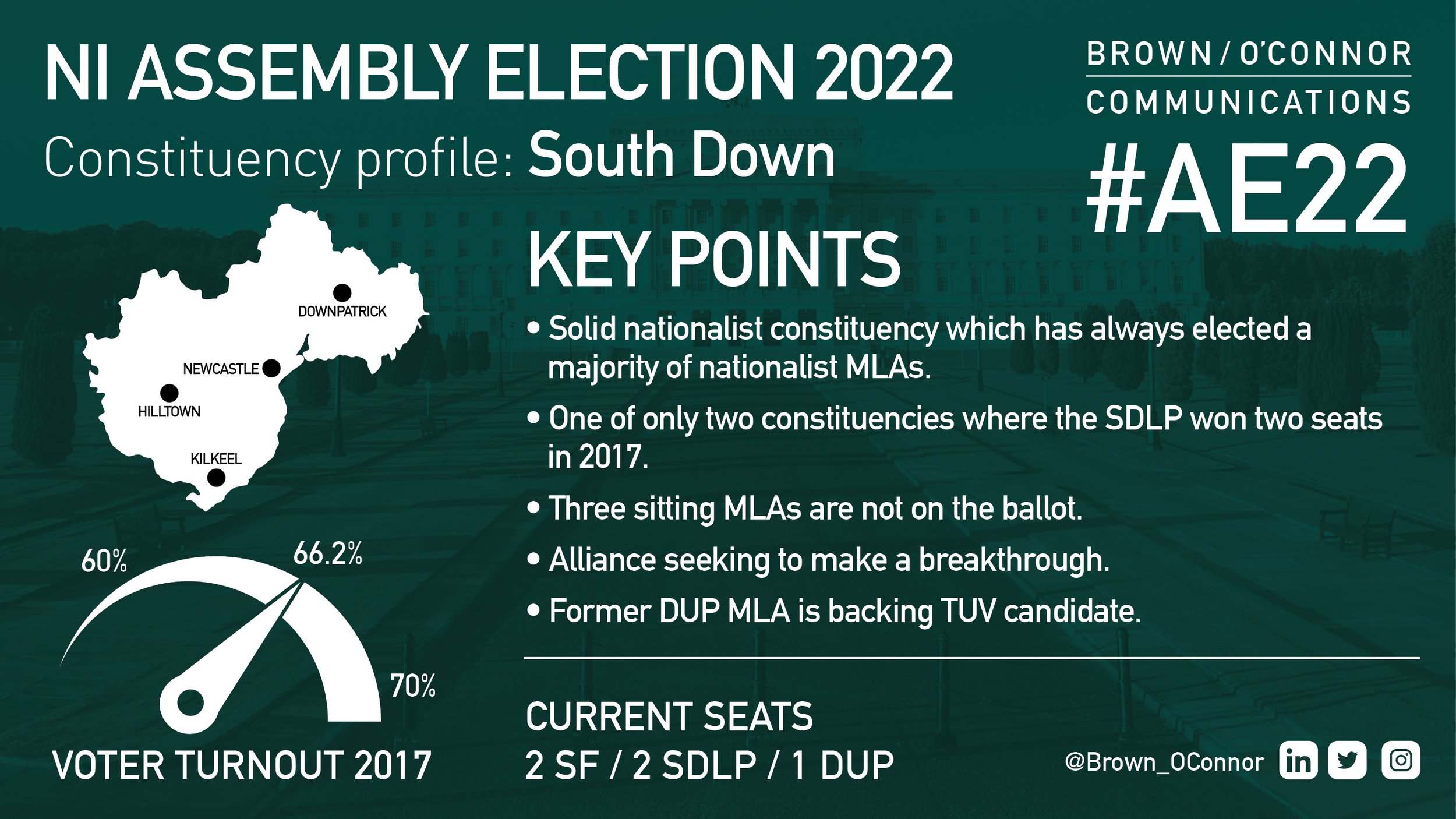#AE22 Constituency Profile: South Down
ABOUT THE CONSTITUENCY
South Down is a large constituency which includes the Mountains of Mourne, the northern shore of Carlingford Lough, Kilkeel, Newcastle, Warrenpoint and the village of Strangford. Downpatrick is the largest town with a population of just over ten thousand.
The hamlet of Katesbridge is in the north-western part of the constituency and is often mentioned in early morning weather reports as the coldest location in Northern Ireland (due to its situation in drumlin countryside).
The constituency has the third largest electorate eligible to vote in May’s poll.
PREVIOUS ELECTIONS
Sinn Féin achieved a record result in 2017 with 38.6% of the vote, continuing the trend of increasing their vote at every Assembly election.
Meanwhile, SDLP fell below 30% of the vote for the first time since 1998 (when they won 3 of the 6 seats).
DUP bucked the trend with a 3.5% increase in vote share.
Alliance had a record result of 9.2% at the last Assembly election (stretching that to a vote share of 13.9% at the 2019 Westminster poll).
SINCE 2017
Sinn Féin MLA Chris Hazzard was elected to Westminster at the 2017 General Election.
Emma Rogan was co-opted into his seat but was de-selected by the party for May’s election.
Sinéad Bradley is not standing again for the SDLP.
Jim Wells was deselected by the DUP and is not seeking re-election. He has recently quit the DUP and declared his support for the TUV candidate.
THE DAY OF THE COUNT
If the first preference tallies for Sinn Féin and the SDLP fall below 60%, that’s likely to favour Alliance picking up the fifth seat.
To date, Alliance have never beaten 10% vote share at an Assembly election in South Down, and their high water mark at Westminster was 13.9%.
In 2017, there was a gap of three and a half thousand first preference votes between the DUP and UUP, and also between the UUP and TUV candidates. Will voters punish the DUP for deselecting Jim Wells? And will Harold McKee attract support from UUP and Jim Wells to TUV?
COMMENTARY
South Down has always been a hotly contested seat within nationalism since 1998, with Sinn Féin and the SDLP picking up more than 60% of the votes and a majority of the seats.
Sinn Féin outpolled the SDLP for the first time at Assembly level in 2017 and will be seeking to hold that position. Chris Hazzard was returned to Westminster in 2019 but with a big swing of over 7% away from him. Alliance and Aontú were the beneficiaries. Hazzard’s replacement on the Assembly benches upon becoming an MP was Emma Rogan. Subsequently de-selected by the party, local councillor Cathy Mason takes Rogan’s place on May’s ballot paper, running alongside incumbent MLA, Sinéad Ennis.
With the SDLP’s Sinéad Bradley not seeking re-election, Councillor Karen McKevitt has put herself forward for a return to Stormont, having served there 2011–2016. She’ll be on the ticket beside incumbent Colin McGrath, who held his seat in 2017 by 738 votes over Alliance’s Patrick Brown. With Brown’s strong Westminster performance in 2019, Alliance will be fighting to take control of the second SDLP seat.
It’s all change among the unionist candidates. Incumbent DUP MLA Jim Wells was not selected and is replaced with Councillor Diane Forsythe who bested former party leader Edwin Poots for the South Down nomination. She will be the favourite to hold the only unionist seat in the constituency.
TUV candidate Harold McKee was the UUP MLA for South Down from 2016-2017. He left the UUP in October 2021, blaming Doug Beattie’s promotion of “liberal issues”. Jim Wells is backing him at this election. Councillor Jill Macauley is running for the UUP.
PREDICTIONS
Two Sinn Fein, One DUP, One SDLP
The fifth seat is likely to flip from the SDLP to Alliance.












